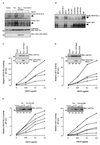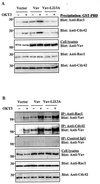Vav-Rac1-mediated activation of the c-Jun N-terminal kinase/c-Jun/AP-1 pathway plays a major role in stimulation of the distal NFAT site in the interleukin-2 gene promoter
- PMID: 11287617
- PMCID: PMC86940
- DOI: 10.1128/MCB.21.9.3126-3136.2001
Vav-Rac1-mediated activation of the c-Jun N-terminal kinase/c-Jun/AP-1 pathway plays a major role in stimulation of the distal NFAT site in the interleukin-2 gene promoter
Abstract
Vav, a hematopoiesis-specific signaling protein, plays an important role in T-cell development and activation. Vav upregulates the expression of the interleukin-2 (IL-2) gene, primarily via activation of the distal NFAT site in the IL-2 gene promoter (NFAT-IL-2). However, since this site cooperatively binds NFAT and AP-1, the relative contribution of Vav to NFAT versus AP-1 activation has not been determined. Here, we studied the respective roles of the AP-1 and NFAT pathways in the T-cell receptor (TCR)-mediated, Vav-dependent activation of NFAT-IL-2. Although Vav stimulated the transcriptional activity of an NFAT-IL-2 reporter gene, it failed to stimulate the transcriptional or DNA-binding activities of an AP-1-independent NFAT site derived from the human gamma interferon gene promoter. Vav also did not stimulate detectable Ca(2+) mobilization and nuclear translocation of NFATc or NFATp. On the other hand, Vav induced the activation of Rac1 or Cdc42 and c-Jun N-terminal kinase (JNK), enhanced the transcriptional and DNA-binding activities of AP-1, and induced increased phosphorylation of c-Jun. Dominant-negative Vav and/or Rac1 mutants blocked the TCR-mediated stimulation of these events, demonstrating the physiological relevance of these effects. Vav also associated with Rac1 or Cdc42 in T cells, and anti-CD3 antibody stimulation enhanced this association. These findings indicate that a Rac1-dependent JNK/c-Jun/AP-1 pathway, rather than the Ca(2+)/NFAT pathway, plays the predominant role in NFAT-IL-2 activation by Vav.
Figures





Similar articles
-
Pleiotropic defects in TCR signaling in a Vav-1-null Jurkat T-cell line.EMBO J. 2002 Sep 16;21(18):4809-19. doi: 10.1093/emboj/cdf499. EMBO J. 2002. PMID: 12234921 Free PMC article.
-
Vav-induced activation of the human IFN-gamma gene promoter is mediated by upregulation of AP-1 activity.FEBS Lett. 2002 Mar 13;514(2-3):153-8. doi: 10.1016/s0014-5793(02)02316-5. FEBS Lett. 2002. PMID: 11943142
-
Tyrosine phosphorylation of Vav stimulates IL-6 production in mast cells by a Rac/c-Jun N-terminal kinase-dependent pathway.J Immunol. 1999 Jul 15;163(2):802-10. J Immunol. 1999. PMID: 10395673
-
SWAP-70-like adapter of T cells: a novel Lck-regulated guanine nucleotide exchange factor coordinating actin cytoskeleton reorganization and Ca2+ signaling in T cells.Immunol Rev. 2009 Nov;232(1):319-33. doi: 10.1111/j.1600-065X.2009.00839.x. Immunol Rev. 2009. PMID: 19909373 Free PMC article. Review.
-
Vav family exchange factors: an integrated regulatory and functional view.Small GTPases. 2014;5(2):9. doi: 10.4161/21541248.2014.973757. Small GTPases. 2014. PMID: 25483299 Free PMC article. Review.
Cited by
-
Coronin 1A promotes a cytoskeletal-based feedback loop that facilitates Rac1 translocation and activation.EMBO J. 2011 Aug 26;30(19):3913-27. doi: 10.1038/emboj.2011.310. EMBO J. 2011. PMID: 21873980 Free PMC article.
-
The N-terminal 20-amino acid region of guanine nucleotide exchange factor Vav1 plays a distinguished role in T cell receptor-mediated calcium signaling.J Biol Chem. 2013 Feb 8;288(6):3777-85. doi: 10.1074/jbc.M112.426221. Epub 2012 Dec 27. J Biol Chem. 2013. PMID: 23271736 Free PMC article.
-
Vav1: A Dr. Jekyll and Mr. Hyde protein--good for the hematopoietic system, bad for cancer.Oncotarget. 2015 Oct 6;6(30):28731-42. doi: 10.18632/oncotarget.5086. Oncotarget. 2015. PMID: 26353933 Free PMC article. Review.
-
Vav1/Rac-dependent actin cytoskeleton reorganization is required for lipid raft clustering in T cells.J Cell Biol. 2001 Oct 29;155(3):331-8. doi: 10.1083/jcb.200107080. Epub 2001 Oct 29. J Cell Biol. 2001. PMID: 11684704 Free PMC article.
-
The Multifaceted Output of c-Jun Biological Activity: Focus at the Junction of CD8 T Cell Activation and Exhaustion.Cells. 2020 Nov 13;9(11):2470. doi: 10.3390/cells9112470. Cells. 2020. PMID: 33202877 Free PMC article. Review.
References
-
- Bagrodia S, Derijard B, Davis R J, Cerione R A. Cdc42 and PAK-mediated signaling leads to Jun kinase and p38 mitogen-activated protein kinase activation. J Biol Chem. 1995;270:27995–27998. - PubMed
-
- Bagrodia S, Taylor S J, Creasy C L, Chernoff J, Cerione R A. Identification of a mouse p21Cdc42/Rac activated kinase. J Biol Chem. 1995;270:22731–22737. - PubMed
-
- Beals C R, Clipstone N A, Ho S N, Crabtree G R. Nuclear localization of NF-ATc by a calcineurin-dependent, cyclosporin-sensitive intramolecular interaction. Genes Dev. 1997;11:824–834. - PubMed
-
- Billadeau D D, Mackie S M, Schoon R A, Leibson P J. Specific subdomains of Vav differentially affect T cell and NK cell activation. J Immunol. 2000;164:3971–3981. - PubMed
-
- Chow C-W, Rincon M, Cavanagh J, Dickens M, Davis R J. Nuclear accumulation of NFAT4 opposed by the JNK signal transduction pathway. Science. 1997;278:1638–1641. - PubMed
Publication types
MeSH terms
Substances
Grants and funding
LinkOut - more resources
Full Text Sources
Other Literature Sources
Research Materials
Miscellaneous
